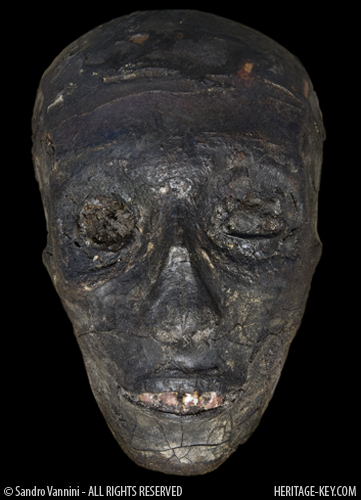 This Wednesday the long awaited results of the DNAresearch on King Tut’s mummy – and some of his possible family members – will be announced at a press conference with Egyptian Minister of Culture, FaroukHosni and Dr. Zahi Hawass. They will announce new discoveries surrounding the family of Tutankhamun and the cause of the young king’s death.
This Wednesday the long awaited results of the DNAresearch on King Tut’s mummy – and some of his possible family members – will be announced at a press conference with Egyptian Minister of Culture, FaroukHosni and Dr. Zahi Hawass. They will announce new discoveries surrounding the family of Tutankhamun and the cause of the young king’s death.
The study on the family of Tutankhamun (keep an eye on all things Tut on our dedicated page) was conducted through the Egyptian Mummy Project (EMP) headed by Dr. Zahi Hawass, and a team composed of Egyptian scientists from the National Research Center, members from the Faculty of Medicine at Cairo University, and two German DNA specialists.
Tutankhamun – Cause of Death?
In the past, the EMP has conducted two further studies on ancient Egyptian mummies. The first project, carried out in 2005, performed a CT-scan of the mummy of Tutankhamun. The study concluded the king had died aged 19, but contrary to earlier speculation had not been murdered by a blow to the back of the head – Egyptian scientists revealed that the hole was created post-mortem during Dynasty 18, in order to insert mummification liquid.
“It was a hole that they opened in Dynasty 18 when they do mummification,” Hawass explains in this video.
The scientists also noted that the king suffered a fracture to his left leg a day or so before his death. Will there be conclusive evidence that this was the cause of the young Pharoah’s demise?
King Tut’s Parentage:A. Amenhotep III , B. Akhenaten or C. Someone Else?
We’re anxiously awaiting the announcement of not only the CoD, but also more information on Tutankhamun’s family tree. King Tuts parentage is a matter of intense debate. Initially it had been thought that Tutankhamun was the brother of Akhenaten and the son of Amenhotep III. Recent evidence, however, has indicated that he was in fact born in Tell el-Amarna – the short-lived 18th Dynasty capital of Egypt – and was most likely the son of Akhenaten.
King Tut Video with Dr Hawass:
VIDEOHow did King Tut Die?
VIDEOThe Curse of the Mummy
VIDEOThe Robbing of King Tut’s Tomb
VIDEOTutankhamun’s Treasures
A match of King Tut’s yDNA(passed on from father to son) will not be able to sort out the above question, though. Shared yDNA would leave the possibility open that Amenhotep IIIis Tutankhamun’s grandfather, and the DNAwas passed through Akhenaten (aka Amenhotep IV), or any other son of Amenhotep III. Yet, in case of a match, it will confirm that Amenhotep III’s mummy is actually labelled correctly. But then again, in case of a mis-match, it is still possible…wait – did they have milkmen in ancient Egyptian times?
Shortly summarised:although the information from the press conference will surely be interesting – is it Wednesday already?!! – it might not be conclusive. Rather, more pieces will be added to the mystery of the Pharaohs, and our Boy King in particular.

Testing Ancient DNA
The study on King Tut’s DNAwas conducted inside two DNA laboratories under the supervision of the Supreme Council of Antiquities. One is located in the basement of the Cairo Museum (have a peek in the museum’s basement in this video), and another is in the Faculty of Medicine at Cairo University. These are the only two DNA laboratories aimed exclusively at the study of ancient mummies.
Mummy DNA is different from that of living people: “It is very old and fragile, so we have to extract and multiply it before tests,” says Dr. Hawass. The DNAsamples on mummies are taken by entering the same puncture hole from a number of different angles with a bone marrow biopsy needle, a less invasive technique than those employed by previous researchers.
Queen Hatshepsut’s Tooth
The EMPs second project succeeded in identifying the mummy of Queen Hatshepsut from remains found in KV60 in the Valley of the Kings, by matching her mummy (the obese woman from KV60) with a molar found in a wooden box inscribed with Hatshepsuts throne name. As usual in the ‘who’s who’ of mummies, this is still debated by some, saying the obese mummy was actually Queen Hatshepsut’s wet nurse.
Anyway, we’ll be holding our breath for the next 48 hours. If you can’t stand the anticipation and need some distraction, do check out our Ancient World in London series. There’s quite a bit going one:Win a book by writing the most romantic, hilarious or original ancient world-inspired love declaration or personal; put your questions to the London Stone on Twitter (for a Roman stone, he’s quite up with the times) or join our Bloggers Challenge on who best invaded London. Else, have a guess, what is the Grand News we can expect to come out of Wednesday’s press conference at the Cairo Museum, .